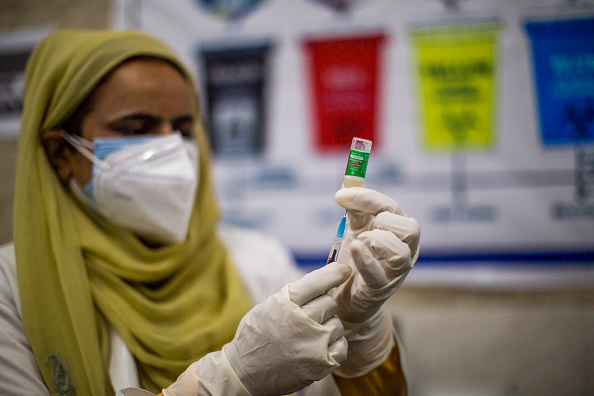
Experts are warning against the perils of a third wave of the pandemic which could spell disaster as kids who are yet to be vaccinated will be vulnerable against the coronavirus REPRESENTATIONAL IMAGE: Getty
The question often asked: Why is the medical fraternity so worried about the third wave when they have grossly failed to deal with the second?
To answer this question one has to consider the coronavirus and its various mutations as a thinking being—that’s bent upon posing an existential challenge to humanity. In the past, variants and mutations indicate that it’s trying to outsmart humans—or the scientific establishment all over the world. Broadly, the trend has been, as has been established by various studies, and also indicated by trends, as case profiles, that the first wave targeted the elderly populations, while the second wave was rather indiscriminate—a study in Delhi revealed that half of the causality was within the age group of 18 to 41 years.
Also, children, below 18 years, will remain a segment of the population that will remain unvaccinated and therefore an easy target for the pandemic. That is why US President Joe Biden has already declared his plans to vaccinate the population that falls in the age group of 12 to 15 years. “We need you all to get vaccinated,” he stressed in his later Instagram post, kids 12 and up can now get the Pfizer COVID-19 vaccine. Go to vaccines.gov and find a vaccine near you.”
One of the early correspondence of Temitope Fisayo and Sonia Tsukagoshi of King’s College London School of Medicine, Guy’s Campus, London, explains the three waves of Covid-19 based on the UK experience. The three waves are basically about how “the virus manifests over different time frames” and the pandemic will not necessarily be over “until we are through the impact of the ‘third wave’ of the Covid-19 pandemic.”
In the first wave, “deaths and disability are directly linked to Covid-19” while “untold number of people are living with the lasting aftermath of a severe acute respiratory syndrome coronavirus 2 infection—for some, even mild Covid-19 can be debilitating for months on end, even after they are clinically cured of the infection.”
The second wave is about those who “will suffer in the medium-term due to measures taken to limit the spread of Covid-19” like those who delay presenting to healthcare facilities for fear of Covid-19 infection; those with progressive diseases whose appointments are rescheduled; and those who miss routine screening.
While the third would be about the “effect of the virus on the social determinants of health, and its effects on the next generation.”
Further, children who have already been locked out of schools…will never compensate for their months of lost education, also parental loss of income will impact children’s diets, housing, and educational opportunities. Children would lose even more space to socialise safely, potentially having to settle for obesogenic spaces such as fried chicken shops. Add to this, lockdown means an increased risk of child abuse and domestic violence, both adverse childhood experiences with demonstrated repercussions in later life.
The third wave will direct sting to the most vulnerable–the children, and “the virus has got into everything. It’s in our funding decisions, our legal protections, our hearts, (and) our minds. The pandemic cannot be ‘over’ until it is reckoned within every sphere of our lives. But there’s hope if (the) plan in advance, as the “third wave doesn’t have to crash on undefended shores.”
“The current pandemic is likely to last for about 4 to 5 months. And then we should be prepared for the third wave,” said Dr Devi Shetty, noted cardiac surgeon and chairman, Narayana Health in an online address at the Symbiosis Golden Jubilee Lecture Series. The severity will depend also on how prepared we are with medical infrastructure and supply chains. “We need to produce at least two lakh nurses and at least one and a half lakh doctors in the next few weeks who are dedicated to managing Covid-19 for the next one year,” Dr Shetty asserted.
Dr Shahid Jameel, virologist and director of the School of Biosciences at Ashoka University, supported Dr Shetty’s concerns when he said, “we should never again be caught with inadequate infrastructure (hospitals and doctors), poor supply chains (medicines, oxygen) and most importantly, shoddy planning.”
He was of the view vaccines are powerful tools, but needs time to act, therefore would be of “no longer help to contain the current second wave because they take 6-8 weeks to show protection, they will reduce the intensity of future outbreaks.” Dr Jameel added, “the task, therefore, is to vaccinate as many people as quickly as possible. This requires proper planning to ensure adequate supplies, delivery points, and effective communication.” He’s not happy with the progress so far, “unfortunately, for reasons of hesitancy and poor communication, we lost valuable time in January and February when the daily caseload was reducing. Now, it is an uphill battle.”
So act now or we’ll repent in leisure.
A scientific committee has been constituted, which has already held meetings to recommend effective pollution-control…
He said NIA has the supervening power of taking over all the investigation, particularly in…
Delhi saw 14 murders in 15 days, with police expressing concern over the involvement of…
Vehicles without a valid PUC certificate will not be allowed to refuel at petrol pumps…
Six passengers from Bangkok were arrested at IGI Airport after customs seized over 48 kg…
Delhi Police arrest three men, a woman and a juvenile in Mukherjee Nagar stabbing; woman…